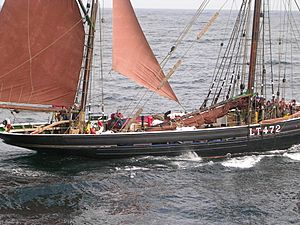Excelsior (smack) facts for kids
The Excelsior is a famous old fishing boat from Lowestoft, England. She is part of the National Historic Fleet, which means she's a really important ship from history. Built in 1921, she worked as a fishing boat until 1936.
After that, she was changed into a motor coaster and was called Svinor. She sailed mostly in Norway. In 1972, she came back to Lowestoft. The Excelsior was restored in 1989. Today, she is used for sail training, teaching people how to sail. She can carry up to 17 people, including 12 trainees.
Contents
The Amazing History of Excelsior
How Was Excelsior Built?
The Excelsior was built in 1921 by John Chambers & Co. in Lowestoft. This company was known for building great fishing smacks. The ship's design was very good, and she was built to be strong. She was even built by young apprentices learning their trade after World War I.
After fishing for 14 years, she was sold to Norway. There, she was changed into a motor coaster, which is a ship that carries cargo. Her hull (the main body of the ship) was still very new, so only small changes were made. She could carry about 100 tons of goods.
Why Was Excelsior Restored?
In the 1970s, a man named John Wylson wanted to find an old sailing ship to restore. He found Excelsior in Norway. She was still in good shape, even though she needed some repairs. At that time, there were no large Lowestoft fishing smacks still sailing in the UK.
So, John Wylson and Mark Trevitt decided to buy her and bring her back to Lowestoft. They wanted to restore her to look just like she did when she was first built. They used old photos and talked to people who used to work on these ships. This was possible because Lowestoft was one of the last places to use large fishing smacks.
Today, Excelsior has some original parts, some exact replacements, and some new parts. The new parts help her meet modern safety rules and earn money for her upkeep. For example, she has an engine and modern navigation gear.
Excelsior's Role in History
Lowestoft was a very busy fishing port in the 20th century. It had the largest fleet of sailing trawlers. Excelsior is a great example of these important ships.
Her first captain, Jimmy Strong, even fought German U-boats in World War I. Some fishing boats were fitted with guns to defend themselves. This shows how brave the fishermen were.
During World War II, when Excelsior was called Svinor and was in Norway, she helped people escape bombing. She carried townsfolk to safety on nearby islands. This shows her role in helping people during difficult times.
Excelsior on Screen
Excelsior has also become a bit of a movie star! She has appeared in many TV shows and films. You might have seen her in:
- Channel 4's The Real History Show: Fish and Ships
- BBC's The Last Journey of John Keats
- Disney's Alice Through the Looking Glass
- Christopher Nolan's Dunkirk
She has also been featured in shows like ITV's Anglia Afloat and BBC's Coast.
What Made Lowestoft Smacks Special?
Lowestoft fishing boats, like Excelsior, had special features. These features helped them fish well in the North Sea.
- They were big enough to fish for several days without returning to port.
- They had a deep hull and a straight keel. This helped them handle rough seas in winter.
- Their bows (front part of the ship) were full and strong. This helped them in the short, steep waves of the North Sea.
- They were set up to cast their fishing nets from the left (port) side.
- They used a smaller boat (14 feet) compared to other fishing fleets.
- They didn't have a special opening in the side for the boat. This was because they landed their catch right at the dock in Lowestoft.
- They used a "cutter rig" for their sails. This was powerful and easy for the crew to manage.
Later, around the 1870s, steam-powered winches were added to pull in the nets. This meant fewer crew members were needed. Because of this, the sail plan changed to a "ketch rig." This broke the sails into smaller, easier-to-handle pieces.
Excelsior was one of the last smacks built in Lowestoft. She shows the best design features developed over many years.
Excelsior: A Living Museum Ship
Excelsior has spent most of her life as a Lowestoft fishing smack or as a historic sail training vessel. She has traveled over 130,000 miles and been seen by millions of people. She has taken about 10,000 people to sea to experience sailing a traditional fishing boat.
In 2016, she was named a "Regional Flagship of the Year." This shows how important she is. Excelsior is not just an old ship in a museum. She is a working ship that keeps history alive. She helps people learn about old sailing skills and how to maintain wooden ships.
The people who care for Excelsior believe that keeping her sailing is the best way to preserve her. A wooden ship can rot quickly if it stays in port. By sailing, she stays strong and helps pass on important skills to new generations.


